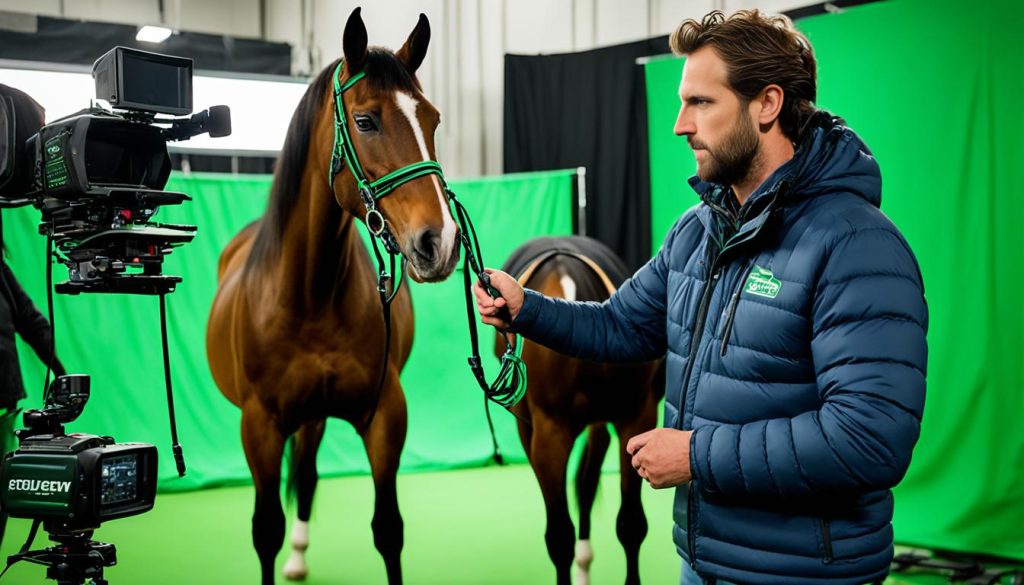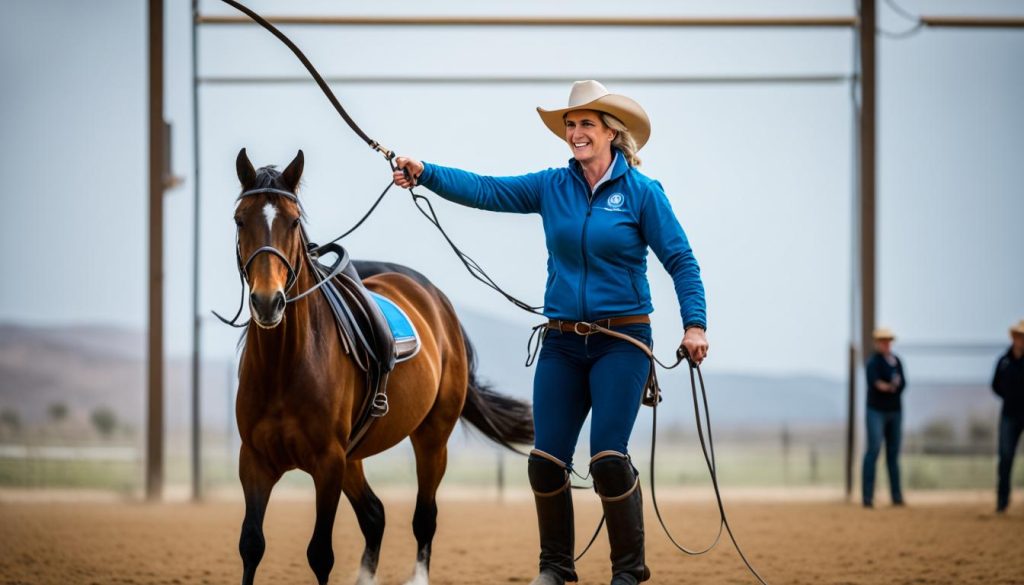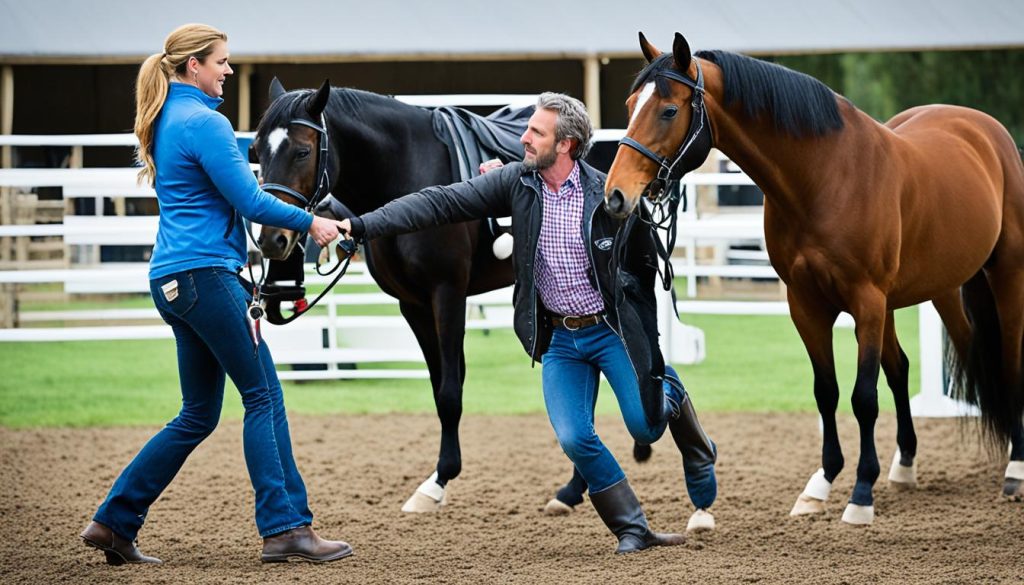Did you know that horse training plays a vital role in the success of many films and television shows? Trained horses bring authenticity and depth to on-screen performances, captivating audiences with their realistic behaviors and seamless interactions with actors. Whether it’s teaching horses for TV shows or preparing equine actors for movie roles, horse training in the entertainment industry is a specialized craft that requires expertise, dedication, and a deep understanding of both horses and the demands of the industry.
In the world of film and television, Dolbadarn Film Horses has established itself as a reputable source for training and supplying horses. Located in North Wales, UK, this renowned company specializes in preparing horses for the screen, focusing on two types of horses: “Actor” trained horses, which are intelligent and adaptable, and action/stunt horses, which are athletic and fearless. The training process emphasizes safety and consistency, as the horses must perform reliably in front of cameras and with actors on their backs.
Why is horse training so essential for the entertainment industry? How do trainers select the right horses for film and television? Let’s explore the world of horse training in the film and television industry, and gain insights into the challenges, considerations, and ethical aspects that trainers and production teams must navigate.
Key Takeaways:
- Horse training is crucial for creating authentic and captivating on-screen performances.
- Dolbadarn Film Horses is a renowned source for training and supplying horses in the film and television industry.
- Training focuses on two types of horses: “Actor” trained horses and action/stunt horses.
- Safety, reliability, and the establishment of trust are key factors in the training process.
- Trainers consider breed, temperament, physical appearance, and skills when selecting horses for film and television.
The Importance of Horse Training for Film and Television
Horse training is an essential aspect of preparing equine actors for film and television. Trained horses are able to perform specific behaviors and actions on cue, following the instructions of their riders or trainers. The training process involves teaching horses to respond to various signals and cues, such as voice commands, hand movements, or leg pressure. This level of training ensures that the horses can perform consistently and safely on set, even in challenging or high-stress situations.
Proper training also helps to establish a bond of trust between the horse and the actor or rider, ensuring a smooth and successful performance. When horses are well-trained, they can easily adapt to new environments, work together with other horses, and complete complex tasks with confidence. This versatility is crucial in the fast-paced world of film and television production, where time constraints and multiple takes are common. Trained horses make the entire process more efficient and allow for greater creative freedom in storytelling.
The training process involves teaching horses to respond to various signals and cues, such as voice commands, hand movements, or leg pressure.
When an equine actor is required to perform a specific behavior, such as galloping, jumping, or even rearing, the training they receive enables them to execute these actions realistically and precisely. This level of control allows directors and cinematographers to capture the desired shots without compromising the safety of the horse or endangering the cast and crew.
The importance of horse training extends beyond the practical aspects of on-screen performance. Trained horses also contribute to the emotional and visual impact of a production. Their presence on set brings a sense of authenticity and grandeur to the scenes, enhancing the overall cinematic experience for the audience.

In conclusion, horse training for film and television plays a vital role in bringing stories to life. Trained horses provide the necessary skills, reliability, and adaptability required for successful on-screen performances. They contribute not only to the safety and efficiency of the production process but also to the visual and emotional impact of the final product.
Challenges and Considerations in Horse Training for Film and Television
Training horses for film and television presents its own unique set of challenges and considerations. In order to create cinematic horse behaviors that captivate audiences, horses must be taught to perform specific actions and reactions that may not come naturally to them.
Teaching horses for TV shows involves training them to respond to visual or auditory cues, perform stunts and tricks, and navigate unfamiliar environments. These behaviors require careful and patient training, as horses need to understand and execute precise movements while ensuring their safety and the safety of those around them on set.
A crucial aspect of film and TV horse handling is acclimating horses to the various stimuli they may encounter during production. This includes loud noises, special effects, and crowded spaces. Trainers aim to desensitize horses to these elements and build their confidence, allowing them to perform reliably even in high-stress environments.
Working with different types of horses poses another challenge in horse training for film and television. Each horse possesses its own personality, strengths, and training needs. Trainers must adapt their approaches to accommodate these individual differences and unlock each horse’s full potential.
“The horse can only be prepared for what it will encounter on set if we carefully consider the challenges posed by the specific project and create a training program that addresses them,” says Sarah Williams, a renowned horse trainer in the entertainment industry.
The Art of Preparing Horses for Film and Television
Successful horse training for film and television requires a combination of technical expertise, creative problem-solving, and a deep understanding of equine behavior. By addressing the challenges and considerations specific to this field, trainers can shape horses into versatile performers that bring authenticity and magic to the screen.

| Challenges | Considerations |
|---|---|
| Training horses to perform specific behaviors | Horse and cast/crew safety on set |
| Familiarizing horses with visual and auditory cues | Comfort with loud noises, special effects, and crowded spaces |
| Working with different horse personalities and training needs | Adapting training methods to suit individual horses |
Choosing the Right Horses for Film and Television
When it comes to selecting horses for film and television, there are several important factors to consider. The breed, temperament, physical appearance, and skill set of the horse all play a role in determining their suitability for the job. Production teams often have their own preferences and requirements, so it’s essential to find the right match for each project.
Popular breeds used in the film and television industry include the Pure Bred Spanish horses, Friesians, and Lusitanos. These breeds are known for their intelligence, versatility, and beautiful appearances, making them ideal for on-screen performances.
To ensure a successful production, trainers and production managers look for horses that are intelligent, trainable, and adaptable. These horses need to have the right temperament to handle the demands of the job, which can often involve challenging and unfamiliar situations. Whether it’s a demanding lead role or a stunt horse, finding a horse with the appropriate skills and qualities is crucial.
Furthermore, specific skills such as trick riding, carriage driving, or mounted combat can make a horse highly sought after in the industry. These specialized abilities can add an extra layer of excitement and authenticity to the on-screen performances.
Overall, the process of choosing the right horses for film and television requires careful consideration and expertise. It’s essential to find horses that not only meet the production’s needs but also have the temperament and skills to perform consistently and convincingly on screen.

Comparison of Popular Breeds for Film and Television
| Breed | Temperament | Physical Appearance | Special Skills |
|---|---|---|---|
| Pure Bred Spanish horses | Intelligent and highly trainable | Elegant and regal | Excellent dressage abilities |
| Friesians | Gentle and willing to please | Powerful and majestic | Strong for carriage driving |
| Lusitanos | Versatile and versatile | Graceful and athletic | Well-suited for trick riding and mounted combat |
Evolution of Horse Training in the Film Industry
Horse training in the film industry has come a long way, adapting to advancements in technology and a greater focus on animal welfare. Early Hollywood films often subjected horses to grueling working conditions, risking injury or even death. However, the industry has since recognized the importance of ensuring the safety and well-being of animals during production.
“Early Hollywood films often subjected horses to grueling working conditions, resulting in injury or even death.”
The American Humane Association is one of the organizations that closely monitors on-set animal action, making sure that horses and other animals are treated ethically and with care. The standards and guidelines set by such organizations have significantly improved the treatment of horses in the film industry, creating a safer and more humane environment for these magnificent creatures.
Furthermore, advancements in technology have allowed for more creative and flexible portrayals of horses on screen. The use of computer-generated images (CGI) and motion capture technology has reduced the reliance on live animal actors in certain scenes. This shift not only minimizes the risks associated with live animal performances but also opens up new possibilities in visual storytelling.
Horse training for film and television has evolved into a collaborative effort between trainers, filmmakers, and technology, with the shared goal of creating realistic and visually stunning content while prioritizing the welfare of horses.
Adapting to Changing Times
The evolution of horse training in the film industry reflects a growing awareness and responsibility towards animal welfare. Filmmakers and trainers constantly seek ways to improve the training process, ensuring that horses are treated with respect and care throughout their on-screen performances. This includes using positive reinforcement methods, providing appropriate rest periods, and minimizing any potential harm or stress.
The Impact of Technology
The integration of CGI and motion capture technology has revolutionized the way horses are portrayed in films and television shows. This not only allows for more daring and visually stunning horse scenes but also reduces the physical demands on live animal actors. By combining the art of horsemanship with cutting-edge technology, filmmakers can bring their visions to life without compromising the welfare of the horses involved.
Creating Authentic Experiences
The training and handling of horses in the film industry contribute to the authenticity and success of many productions. Well-trained horses can deliver captivating performances, enhancing the overall storytelling. They have the ability to perform complex maneuvers, exhibit specific behaviors, and work seamlessly with actors and crew members. The dedication and expertise of trainers and wranglers ensure that equine actors are prepared for their on-screen roles, enabling them to provide genuine and compelling performances.
Paving the Way for the Future
Horse training for film and television continues to evolve as the industry strives for excellence in both storytelling and animal welfare. As more filmmakers embrace technology and ethical practices, the training process will become more refined, empowering trainers to push the boundaries of what is possible on screen. The legacy of horse training in the film industry is one of innovation, collaboration, and a deep appreciation for the beauty and strength of these magnificent animals.
Ethical Considerations in Horse Training for Film and Television
As the use of horses and other animals in film and television continues, ethical considerations become increasingly important. Ensuring the well-being and safety of the animals involved is paramount. Trainers and production teams must approach horse training with respect and care, using positive reinforcement methods and minimizing any potential harm or stress to the animals.
“We have a responsibility to the horses we work with,” says Jane Roberts, a renowned equine trainer and advocate for animal welfare in film production. “Every step of the training process should prioritize their comfort, trust, and happiness.”
Organizations like the American Humane Association play a crucial role in monitoring and overseeing on-set animal action, ensuring that industry standards are upheld. Their rigorous certification process provides peace of mind to both production teams and audiences, knowing that the animals’ welfare is being safeguarded.
However, there is an ongoing discussion and debate in the industry about the use of live animal actors versus digital and CGI alternatives. While the use of computer-generated images can reduce the risk of harm to live animals, it can also diminish the authenticity and connection that comes from working with real horses.
The Impact of Horse Training in the Film Industry
Horse training plays a significant role in the success of many films and television shows. Well-trained horses can bring authenticity and depth to a production, allowing for realistic and captivating performances. Trained horses can perform complex maneuvers, exhibit specific behaviors, and work seamlessly with actors and crew members. They contribute to the overall storytelling and help create memorable scenes. Moreover, the skill and expertise of horse trainers and wranglers are vital in ensuring the safety and welfare of the animals during filming. The reputation and quality of a production often rely heavily on the training and handling of its equine actors.
In the entertainment industry, Horse Training for Film and Television is highly regarded. Equine actors coaching and film and TV horse handling are critical components of creating believable and visually striking scenes. Trained horses bring characters to life, evoke emotions, and provide a sense of realism that enhances the audience’s viewing experience. Whether it’s a thrilling chase scene, a period drama, or fantastical adventures, well-trained horses deliver performances that captivate and immerse audiences in the story.
“The essential joy of being with horses is that it brings us in contact with the rare elements of grace, beauty, spirit, and fire.” – Sharon Ralls Lemon
In equine actors coaching, extensive training is involved to ensure the horses are comfortable with the on-set environment and able to execute various actions and behaviors on cue. Film and TV horse handling requires the horses to work harmoniously with their human counterparts, following directions and seamlessly adapting to different filming conditions. This level of coordination and cooperation between the horses, trainers, and actors ultimately translates into breathtaking on-screen performances that leave a lasting impact.
The Benefits of Expert Horse Training
Proper horse training conducted by experienced professionals in the entertainment industry provides numerous benefits. By investing time and effort into training equine actors, filmmakers can:
- Create compelling and realistic horse-centric storylines
- Showcase intricate riding styles and maneuvers
- Depict historical or period-specific equestrian culture accurately
- Ensure the safety and well-being of both horses and human cast members
- Elevate the production value and overall quality of the final product
Recognizing Excellence in Horse Training
The entertainment industry acknowledges the crucial role of horse training by presenting awards that specifically honor outstanding equine performances. One such prestigious recognition is the American Humane Hero Animal Award, given to exceptional animal actors who exhibit exceptional training, discipline, and cooperation on set. These accolades further highlight the immense impact and significance of properly trained horses in film and television.
| Award | Purpose |
|---|---|
| American Humane Hero Animal Award | To honor extraordinary animal actors and recognize their exceptional contributions in film and television |
| U.S. Screen Horse Guild Award | To celebrate outstanding horse performances and recognize the skill of the trainers and handlers |
| International Equine Cinema Award | To acknowledge exceptional horse-related performances in films from around the world |
The Continuing Evolution of Horse Training
Horse training for the film industry continues to evolve, embracing new techniques and technologies that enhance the training process and prioritize animal welfare. Trainers and wranglers strive to strike a balance between authentic performances and the ethical treatment of horses during filming. The entertainment industry’s commitment to animal welfare has led to stricter regulations and guidelines to ensure the well-being of equine actors on set.
As the demand for visually stunning films and immersive storytelling grows, the importance of equine actors coaching, film and TV horse handling, and entertainment industry horse training will only continue to increase. Well-trained horses play a pivotal role in creating unforgettable cinematic moments that resonate with audiences for years to come.
Conclusion
Horse training for film and television is an essential and specialized field that requires expertise, dedication, and a deep understanding of horses and the entertainment industry. Trainers and wranglers play a crucial role in preparing equine actors for their on-screen appearances, ensuring their safety, and enabling them to perform reliably and convincingly.
The industry has made significant strides in prioritizing animal welfare and implementing safeguards to protect the well-being of horses and other animals involved in productions. With advancements in technology and increased awareness of ethical considerations, the focus on maintaining the health and happiness of these animals is steadfast.
As the demand for realistic and visually stunning content continues to grow, horse training for film and television insights will continue to be a fundamental and cherished aspect of the entertainment industry. It is through the skill and expertise of trainers that these magnificent creatures are able to bring authenticity and depth to on-screen performances, contribute to storytelling, and create unforgettable moments of cinematic magic.
